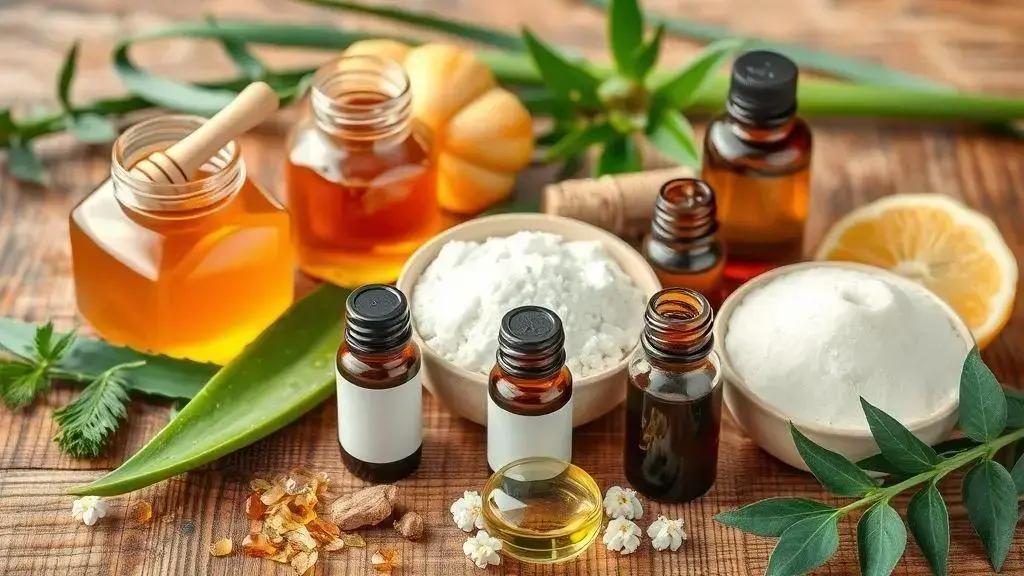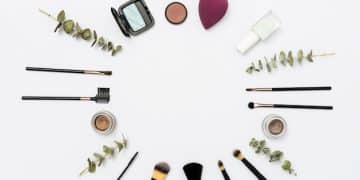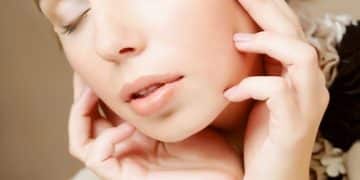Natural DIY skincare recipes for glowing skin

Natural DIY skincare recipes empower you to create tailored, effective products using simple ingredients, enhancing your skincare routine while ensuring safety and satisfaction.
If you’re looking to revive your skin naturally, natural DIY skincare recipes might just be the answer. These homemade solutions not only save money but also allow you to customize your skincare ritual. Ready to explore some fantastic recipes together?
Understanding the benefits of natural ingredients
Understanding natural ingredients is essential for creating effective DIY skincare recipes. These ingredients are often more beneficial for your skin than synthetic alternatives. By using natural components, you can nourish your skin while being environmentally friendly.
Key Benefits of Natural Ingredients
Natural ingredients offer various advantages:
- Gentle on the skin: Most natural ingredients are less likely to irritate your skin.
- Rich in nutrients: They often contain vitamins and antioxidants that help improve skin health.
- Eco-friendly: Utilizing natural components supports sustainable practices and reduces chemical waste.
When creating your DIY skincare products, consider the power of natural ingredients. For instance, aloe vera is renowned for its soothing properties, making it perfect for calming irritated skin. Similarly, coconut oil is an excellent moisturizer due to its deep hydration qualities.
Examples of Natural Ingredients
Here are some common natural ingredients to explore:
- Honey: A natural humectant that attracts moisture to your skin.
- Shea butter: Provides intense hydration and is rich in vitamins A and E.
- Essential oils: Enhance scents and offer various therapeutic benefits.
By incorporating these natural elements into your skincare routine, you can create products that are not only effective but also safe for your skin and the environment. Remember, understanding these benefits is the first step in your journey toward a healthier skincare regimen.
Top 5 DIY skincare recipes for every skin type
When it comes to skincare, DIY recipes can be tailored to suit every skin type. This flexibility allows you to create treatments that address your unique needs. Let’s explore the top 5 DIY skincare recipes that are easy to make, effective, and natural.
1. Hydrating Honey Mask
This mask is perfect for dry skin. Combine 2 tablespoons of honey with 1 tablespoon of coconut oil. Apply it to your face for 15 minutes, then rinse. Honey is a natural humectant, drawing moisture into your skin.
2. Soothing Oatmeal Scrub
If you have sensitive skin, this gentle scrub works wonders. Mix 1/2 cup of oatmeal with 1 cup of water and let it sit for 10 minutes. Apply the mixture to your face, gently scrubbing in circular motions before rinsing off.
3. Refreshing Cucumber Toner
This toner is excellent for oily skin. Blend 1 cucumber and strain the juice. Mix it with 1 tablespoon of apple cider vinegar. Apply it with a cotton ball for a refreshing feel that minimizes pores.
4. Rejuvenating Avocado Cream
For those with normal skin, an avocado cream keeps your skin moisturized. Mash 1 ripe avocado and blend it with 1 tablespoon of olive oil. Apply it as a mask for 20 minutes before rinsing.
5. Brightening Lemon Exfoliant
This exfoliant is great for dull skin. Mix the juice of 1 lemon with 2 tablespoons of sugar to create a paste. Gently scrub your face for a few minutes before rinsing. Be sure to use sunscreen afterwards as lemon can increase sensitivity to sunlight.
Each of these recipes utilizes natural ingredients that are beneficial for your skin. They offer simplicity and effectiveness, ensuring you a refreshing skincare experience at home. Experimenting with these DIY recipes allows you to discover what works best for your skin type and keeps your skincare routine exciting.
How to create your own skincare routine

Creating your own skincare routine can be exciting and rewarding. With a few basic steps, you can tailor a regimen that works best for your skin type. Let’s explore how to build an effective skincare routine.
Step 1: Determine Your Skin Type
Understanding your skin type is essential before starting your skincare journey. Common types include:
- Oily: Shiny with enlarged pores.
- Dry: Flaky and may feel tight.
- Combination: A mix of oily and dry areas.
- Sensitive: Prone to redness and irritation.
Identifying your skin type helps in choosing suitable products.
Step 2: Basic Skincare Steps
A simple skincare routine generally includes three main steps:
- Cleanser: Use a gentle cleanser that removes dirt and oil without stripping moisture.
- Toner: Apply a toner to help restore pH balance and prepare your skin for other products.
- Moisturizer: Hydrate your skin with a hydrating moisturizer suitable for your skin type.
These three steps form the foundation of your skincare regimen and can be adjusted based on personal preferences.
Step 3: Add Targeted Treatments
After the basics, consider adding targeted treatments that address specific concerns such as acne, dark spots, or aging. Ingredients like salicylic acid for acne or retinol for wrinkles can be effective. Introduce these slowly, one at a time, to see how your skin reacts.
Step 4: Maintain Consistency
Consistency is crucial for seeing results. Stick to your routine morning and night, and give each product time to work before introducing new ones. It’s also important to adjust your routine seasonally or as your skin changes.
Finally, don’t forget the importance of sunscreen during the day, as it protects your skin from harmful UV rays. Following these steps can help you cultivate a skincare routine that makes your skin feel healthy and radiant.
Essential tools and materials for DIY skincare
To create effective DIY skincare products, having the right tools and materials is essential. These items make the process easier and ensure better results. Here’s a look at what you need to get started.
Basic Tools Required
Gathering the right tools is the first step in your DIY skincare journey. Essential tools include:
- Mixing Bowls: Glass or stainless steel bowls are ideal for mixing ingredients.
- Spoons and Spatulas: Use these for stirring and scraping the last bits of your creations.
- Measuring Cups and Spoons: Accurate measurement is key to successful recipes.
- Blender or Whisk: For emulsifying or thoroughly mixing ingredients, especially in lotions and creams.
These basic tools will help streamline the DIY process and ensure that all components are combined properly.
Ingredients to Stock Up On
Next, having a selection of quality ingredients is crucial. Here are some must-have materials:
- Carrier Oils: Oils like jojoba, almond, and coconut are great bases for many skincare products.
- Essential Oils: They add fragrance and therapeutic benefits, making your products more enjoyable to use.
- Botanicals: Dried herbs like chamomile or lavender can enhance the properties of your skincare formulations.
- Natural Preservatives: Items like vitamin E oil or rosemary extract can help extend the shelf life of your products.
Having these ingredients on hand allows you to experiment with various recipes and find what works best for your skin.
Storage Solutions
Proper storage of your DIY skincare products is also important. Consider these storage options:
- Glass Jars: They are best for storing creams and scrubs, preventing unwanted reactions.
- Roller Bottles: Perfect for serums and oils, they allow for easy application.
- Airtight Containers: Use these to maintain the integrity of your ingredients and finished products.
With the right tools and materials, making your own skincare products can be a fun and satisfying experience. Each recipe allows you to customize treatments that cater specifically to your needs.
Tips for storing and using homemade products
Properly storing and using your homemade skincare products is key to ensuring their effectiveness and longevity. By following some simple tips, you can maximize the benefits of your creations while keeping them safe.
Storage Tips
Storing your products correctly can make a big difference. Here are some helpful tips:
- Keep in a Cool, Dark Place: Light and heat can degrade many natural ingredients. Store your products in a cool, dark cabinet.
- Use Airtight Containers: Using containers that seal tightly helps prevent moisture and air from spoiling your products.
- Label Your Creations: Make sure to label each product with the date it was made and any key ingredients. This keeps you organized and aware of expiration dates.
These storage practices can help maintain the quality and effectiveness of your homemade skincare items.
Usage Guidelines
Knowing how to use your products is equally important. Here are some guidelines to follow:
- Patch Test First: Always do a patch test on a small area of skin before using a new product to check for any adverse reactions.
- Follow Recommended Amounts: Use the suggested amounts; more isn’t always better. Excess product can clog pores or cause irritation.
- Be Mindful of Expiration Dates: Use products within the recommended time frame to ensure safety and efficacy. Natural products usually have a shorter shelf life.
Incorporating these usage guidelines will help you enjoy your homemade skincare products safely and effectively. With the right storage and usage practices, you can make the most of your DIY creations.
FAQ – Frequently Asked Questions about DIY Skincare
What are the essential tools needed for DIY skincare?
Essential tools include mixing bowls, measuring spoons, and airtight containers for storing your products.
How should I store my homemade skincare products?
Store them in a cool, dark place in airtight containers to prevent degradation and contamination.
Why is patch testing important?
Patch testing helps identify any potential allergic reactions or sensitivities to new ingredients before full application.
How do I know when to discard my DIY skincare products?
Keep track of expiration dates and discard any products that show signs of spoilage, such as changes in color, smell, or texture.





